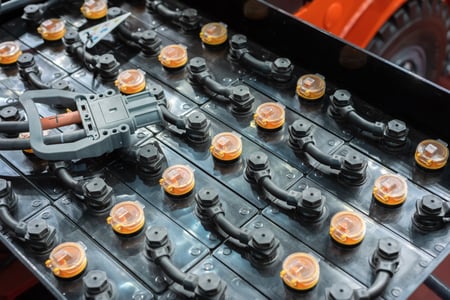 Which seven words, when put in practice, can dramatically increase the uptime of your manufacturing and distribution supply chain? The answer: a reliable, effective forklift battery watering system.
Which seven words, when put in practice, can dramatically increase the uptime of your manufacturing and distribution supply chain? The answer: a reliable, effective forklift battery watering system.
We get it—the answer’s not shiny or exciting, which is why most companies don’t really put a ton of thought into their battery watering system. They do what they’ve always done because it seems to be working. And it does work—just not nearly as well as it could be. In fact, many companies employ sporadic and inefficient watering systems that can shorten battery lifespans by one to three years—a significant amount of time when a battery should last five years.
The truth is that implementing a successful watering system is much more complex than it may seem. Optimizing the process requires a thorough understanding of chemistry and science. Your lead technical person may have this knowledge but the on-the-ground employees are likely busy dealing with urgent issues—never realizing that delaying watering is creating more problems in the long run.
The takeaway? Implementing a successful watering system requires a strategic plan. With that in mind, here are six things to consider when creating a watering system.
1. Keep the Correct Water Levels
The plates within a battery cell should never be below the top of the plates when charging. This prevents the batteries from overheating, drying out the plates, and reducing your battery life. When batteries overheat and dry out, they either lose capacity or become completely unusable. If you notice that plates are above the water-line, you can fix the problem by adding water to about a quarter-inch above the plates. Be sure to avoid completely topping off the battery, though: doing so can cause an overflow and acid will leak, which shortens the battery’s lifespan.
2. Water After Charging
You should never top off the water in the battery before the charge. Not only does the battery need the extra space to compensate for fluid expansion, but charging causes heat build-up, which in turn makes water evaporate. Watering before charging could potentially result in an overflow after it heats up. That will, in turn, throw off the electrolytes, which can significantly shorten the life of the battery and reduce battery runtime.
3. Check Water Levels in Random Pilot Cells Periodically
Because the correct water level is so important to an effective watering system, proper maintenance of your forklift battery requires a schedule of periodic checks. You should be checking two or three pilot cells every five charges or so and once a month to ensure the single-point watering system is filling consistently. This way, you can ensure that the fluid level is a ¼” below the vent well after watering and above the plastic element protector after the charge.
4. Understand the Science
If you’re not familiar with certain scientific principles, it’s easy to believe that forklift power is really just about dealing with water and a battery: nothing too difficult. However, proper battery maintenance is much more complicated than that, and best practices stem from an understanding of the science that is behind proper battery maintenance. Successful systems require understanding electrolyte levels, voltages, and gravity; it is not enough to know that you need to water a battery. You need to understand the science behind it.
5. Have a Watering Schedule/Plan
Watering your forklift batteries should occur on a regular schedule so you don’t destroy your equipment. Typically, the correct schedule for watering is 1-3 weeks, although a variety of factors -- such as temperature and type of utilization -- can influence the exact number. Along with a schedule, it’s crucial to set up a routine inspection to monitor forklift batteries’ water levels. Without a plan or a staggered schedule -- especially in high-velocity facilities -- employees tend to only water the batteries available at the time they are working. This leads to inconsistent maintenance.
Implementing a watering schedule also improves the ease of use: schedules allow you to water more quickly and efficiently, which may increase the lifespan of the battery.
Ultimately, the four key benefits of a watering schedule are decreased expenses, improved safety, optimized performance, and extended life span of the battery.
6. Periodic Maintenance (PM) Service
While periodic maintenance (PM) is not part of day-to-day or even week-to-week operations, it is still important that water levels are checked as part of a PM inspection. This should occur at least annually, though some customers may require semi-annually or quarterly PM services. During a PM inspection, the battery should be washed and serviced in order to control corrosion. To maximize lifespan, the specific gravity of the battery should also be checked. Techs will also check battery voltages to ensure that all of the 12-24 cells are operating at peak efficiency: if even one cell isn’t working properly, the rest of the cells are forced to work harder to compensate.
Proper electric forklift battery maintenance is essential in getting the most life and efficiency out of your batteries as possible, which saves you money down the line.


 Ryan Lynch
Ryan Lynch
